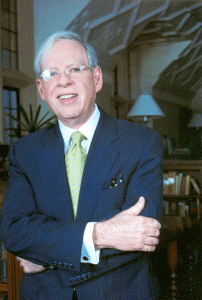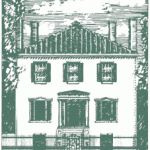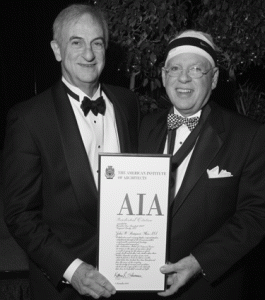
When John Braymer was interviewed for the position of Executive Vice President of the VSAIA, the Executive Committee asked how long he would expect to stay in this position were it offered. (The previous executive had served only 15 months before moving on.) Braymer responded that he expected to serve at least four years, that his real strengths would be as an organization builder not as a maintenance man.
That was 28 years ago. A quick survey of the Society’s evolution over nearly three decades with Braymer at the helm bear out his pledge to build the organization, even as he now plans his departure at the end of his current contract in December.
Braymer recalls his interview fondly. “The six members of the Executive Committee and I just clicked from the outset.” With Richard Ford, FAIA, as chair of the search committee and Immediate Past President, the committee was eager to see Virginia emerge as a leader in the AIA. “But we had a lot of work to do. The headquarters building at the 1844 Barret House had slipped below the ‘shabby gentility’ stage,” Braymer says. “The group was also eager to see a staff built, they were frustrated by an unfulfilled need to be better reflected in publications, and they wanted strong representation in the General Assembly.” On top of that, they hoped to see their next executive become a force within the AIA structure, especially in the Council of Architectural Component Executives (CACE).

Braymer mustered the troops in short order. Within six months, the Virginia Foundation for Architectural Education, owners of the Barret House, had asked Braymer to become its CEO as well, and in the next six months, the Foundation had changed its name, restated its purposes, hired an architect to design the restoration of the historic landmark, and launched its first capital campaign to pay for the nearly $1 million that funded a decade of improvements–to the house, the retaining walls surrounding the property, and the 19th c. ornamental iron fencing.
Both Braymer and the Executive Committee saw the Society’s annual convention as a key in developing a stronger, more cohesive organization. With then treasurer James E. Gehman, AIA, Braymer set off in the fall of 1987 (after a disappointing event in Crystal City) to attend BUILD BOSTON and to study every notable state AIA convention in the country. From that effort emerged the launch of Building Virginia ’88, the first of the long line of annual events that morphed into Architecture Exchange East in this century. “Building Virginia ’88 was approached like any product development,” Braymer recounts. “We established a brand with a concept, a name that did not change annually, a consistent date, and a set location in Richmond. Our members came to know what to expect, and they have repaid that consistency with strong support.”
The development of Inform magazine followed closely on the heels of Building Virginia with its launch in January 1990, in time to capture the Society’s and the Foundation’s notable achievements with renovations of landmark historic properties. In 1993, Braymer announced that the Foundation would launch a center for architecture, the first such center to be developed in the country. Influenced by European architectural centers to which he was exposed by extensive travel abroad, Braymer worked for a decade to secure John Russell Pope’s 1919 Monument Avenue Branch House, finally signing the purchase documents in 2003. With support from the Virginia Society, a $5m campaign to support acquisition and refurbishment costs, as well as a staff re-tooled and expanded for a new public mission, he created and served as the Founding President of the Virginia Center for Architecture until mid-2009.

Along the way, Braymer fulfilled his pledge to be active in the national AIA, serving as host to CACE in 1993, then as its president in 1995, and as a director on the AIA national board in the same year. In that role he served on the Secretary’s Advisory Committee, the Treasurer’s Advisory Committee, and as national co-chair of the Task Force on Collaborative Planning. Braymer was named an Honorary Member of the AIA in 1996, the only member of an AIA component staff so honored that year. He became a Richard Upjohn Fellow of the AIA upon completion of his national service, and on his 2006 20th anniversary with VSAIA he was awarded the Architecture Medal for Virginia Service.
Braymer’s energy and wide interests have not stopped at the AIA’s doorstep. For nearly 10 years he has served the Richmond Symphony as director, most recently as Immediate Past Chairman, a post he still holds. He has also been chairman and director of the Virginia League for Planned Parenthood, Vice Chairman and director of Comfort Zone Camp, a director of the Virginia Board of Historic Resources, appointed by Governor Mark Warner, a director on the City of Richmond’s Monument Avenue Commission, and Treasurer and director of the Center for Palladian Studies in America.
While Braymer’s role with the Virginia Society AIA is coming to an end, “retirement” is not a term that comes easily to mind. Braymer expects to pick up some scholarly threads left dangling over the years when he left his Ph. D. in English and a university teaching career for work in government and–ultimately–the VSAIA. And he will use his Certified Association Executive credential with the American Society of Association Executives to help other non-profits in transition. Braymer is now abroad leading a group of 29 in his tour series called “Palladio at Large: The English Story,” and he expects to continue offering in collaboration with VSAIA and the Virginia Center for Architecture the architecture tours begun in 2000, with tours of London, The Netherlands, and Poland now in the planning stages.
